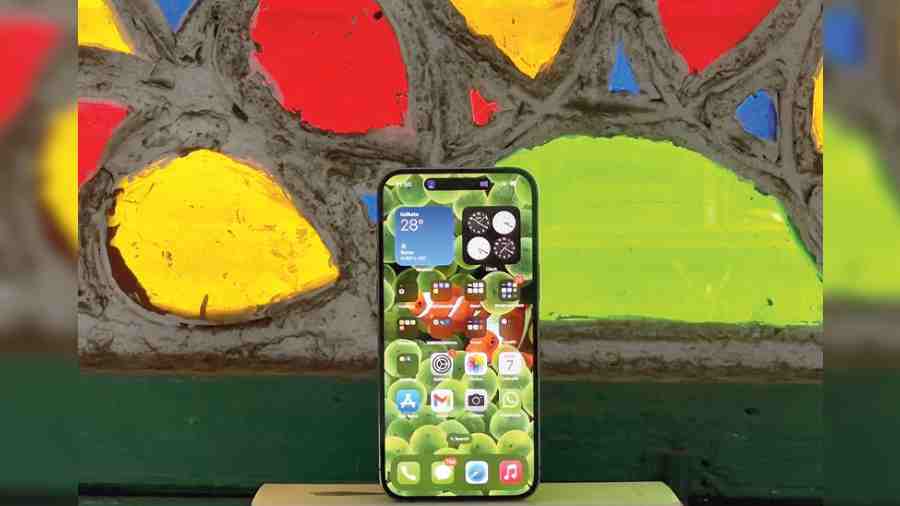When we buy an iPhone in 2022, we are buying a camera that can make calls, browse the Internet and send mails as well as messages. You have already heard (and seen) a lot about the Dynamic Island on the new iPhone 14 Pro and Pro Max. Impressive. But far more impressive is what Apple has done with the camera.
This year, Apple has overhauled the camera system on the Pro models with a 48MP snapper, done the Apple way. Android phones have been using higher megapixels for a long time but the implementation has more or less remained uneven on most phones.
So, you’ve got 4K cinematic mode, you’ve got autofocus that racks like an actual cinema camera, Cinematic Mode in 4K, there is a new 48MP sensor… turn back the clock just 10 years and none of this would been possible. The iPhone and iPhone-inspired smartphones are in everyone’s pockets. We are on a level playing field as far as tech goes but what matters is the story you want to share using the phone.
Snap it on the phone, hang it on the wall
The biggest update on the iPhone 14 Pro is helping you capture a moment when you may not have a professional camera with you. For example, in the middle of a work trip you see autumn in its full glory. The photograph you will click using the new camera set-up is good enough to be printed.
There are a few things to remember when you use the iPhone 14 Pro to capture moments that may find a place on the walls of your apartment.
There are three rear cameras. The main wide-angle 48MP camera. Then there is the optical telephoto camera and an ultra-wide. The main camera has received the most hardware changes. For example, its focal length is wider, going from 26mm equivalent on the previous iPhone to 24mm. That allows you to get more into the frame. The main camera gets a larger 48MP sensor; it’s a 65 per cent larger sensor. More megapixels don’t necessarily mean you get better photos; it’s about how Apple uses those extra pixels.
Ask yourself a question: Do I shoot in regular mode or ProRaw? Regular mode will offer you a JPG file that can be easily shared. The new camera sensor has less image noise and better detail. The main camera takes great photos; image quality and details are great. Where I see a very high degree of improvement is in medium and low-light situations. Colours are excellent, textures are great. If you pixel peep, textures on buildings, ripples on the water… the 14 Pro does a solid job at creating different textures. But these photos are not always suitable for cropping in like 200-300 per cent. This is when you should capture 48MP full-resolution photos using ProRAW. The files will be huge but the technology can crop in on a small part of the photo without losing clarity.
Each file will run into a lot of megabytes, we are talking 40-50MB and that is why the base variant of the phone has 128GB and goes up to 1TB. During a recent work trip I saw autumn in full bloom but I didn’t have my DSLR on me. So, I took out the iPhone 14 Pro Max, made sure ProRaw mode was enabled and took hundreds of pictures, most of which are good enough to be printed. That says a lot because I’m a detail-oriented person and I will never print a photo that I’m not proud of. The iPhone 14 Pro Max allows photos that can be blown up to any size without losing clarity.

The dynamic range is the best an iPhone has ever offered. Also, the iPhone is now conservative with over sharpening images

One of the best options that come with the 48MP camera is using the central quarter of an image to take 12MP shots with a narrower field of view. It shows in the camera app as 2x

The photo shows the colours that phone cameras usually mess up. The iPhone 14 Pro doesn’t disappoint at all

Take photos in 48MP full- resolution using ProRAW. The files will be huge but the technology can crop in on a small part of the photo without losing clarity

Colours are captured perfectly without bumping up the saturation levels
New processing techniques
The camera has the best dynamic range possible on a phone. Be it shadows or a lot of direct sunlight hitting the camera, the output is good enough for pixel peeping. You are often limited when it comes to the size that can be print based on megapixels of your camera but once you reach a certain equilibrium, you can print just about any size. This point is reached at around 20-26MP.
Sunrise and sunset shots are the most difficult to capture, even on a DSLR. To process images, Apple uses Deep Fusion and the new Photonic Engine. The phone is now extracting all the details before an image is compressed. The latter is offering more natural results than when we only had Deep Fusion. We are also getting good low-light images. Also, the time to take shots at night is less, which is probably because there is a bigger sensor and also faster processing via the A16 Bionic chip.
The final images have a film-like look. Of course, everyone processes images differently but you can certainly push the iPhone much more than before. You get cooler tones and there is a degree of muted saturation. Also, the iPhone is now conservative with oversharpening images. There is a less digitally-processed look.
Does it mean you have to buy the iPhone 14 Pro to get the best picture or video? Here’s the deal. Not everyone wants to move to the Apple system and are happy with Android, which has given us two excellent phones this year — Samsung Galaxy S22 Ultra 5G and Google Pixel 7 Pro. There are other Android phones but Samsung and Google are two brands that also offer you a better Android experience.
With the iPhone you are promised a few things. First, it’s the best camera that you can have in your pocket. Second, you will rarely complain (if at all) about missed shots or videos gone corrupt. Third, Apple will continue to push updates to keep the camera relevant for at least five years. Fourth, it’s still the best point-and-shoot phone camera. Where Apple can bring in more improvements is with the ultra-wide lens at night.
Overall, the iPhone 14 Pro has gone a step further into the professional camera segment.
